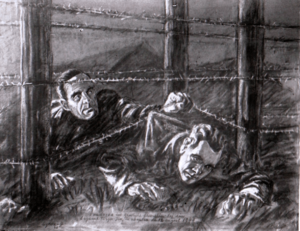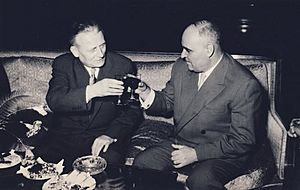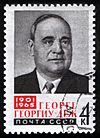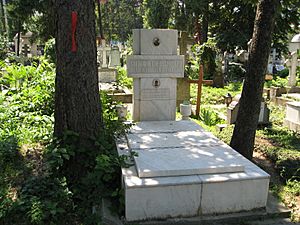Gheorghe Gheorghiu-Dej facts for kids
Quick facts for kids
Gheorghe Gheorghiu-Dej
|
|
|---|---|

Gheorghe Gheorghiu-Dej's official portrait, taken on 8 February 1948, which then became common during his leadership
|
|
| General Secretary of the Romanian Communist Party | |
| In office 30 September 1955 – 19 March 1965 |
|
| Preceded by | Gheorghe Apostol |
| Succeeded by | Nicolae Ceaușescu |
| In office 2 October 1944 – 19 April 1954 |
|
| Preceded by | Ștefan Foriș |
| Succeeded by | Gheorghe Apostol |
| President of the State Council | |
| In office 21 March 1961 – 19 March 1965 |
|
| Preceded by | Ion Gheorghe Maurer (as President of the Presidium of Great National Assembly) |
| Succeeded by | Chivu Stoica |
| President of the Council of Ministers | |
| In office 2 June 1952 – 2 October 1955 |
|
| Preceded by | Petru Groza |
| Succeeded by | Chivu Stoica |
| First Vice President of the Council of Ministers | |
| In office 15 April 1948 – 2 June 1952 |
|
| Prime Minister | Petru Groza |
| Preceded by | Gheorghe Tătărescu |
| Minister of Industry and Commerce | |
| In office 1 December 1946 – 14 April 1948 |
|
| Prime Minister | Petru Groza |
| Preceded by | Petre Bejan |
| Minister of Public Works | |
| In office 6 March 1945 – 30 November 1946 |
|
| Prime Minister | Petru Groza |
| Preceded by | Virgil Solomon |
| Succeeded by | Ion Gh. Vântu |
| Minister of Communications | |
| In office 4 November 1944 – 30 November 1946 |
|
| Prime Minister | Constantin Sănătescu Nicolae Rădescu Petru Groza |
| Succeeded by | Nicolae Profiri |
| Personal details | |
| Born | 8 November 1901 Bârlad, Vaslui County, Kingdom of Romania |
| Died | 19 March 1965 (aged 63) Bucharest, Romanian People's Republic |
| Cause of death | Lung cancer |
| Resting place | Carol Park, Bucharest, Romania (until 1991) Bellu Cemetery, Bucharest, Romania (after 1991) |
| Political party | Communist Party of Romania (1930–1965) |
| Spouse | Maria Alexe |
| a. First Secretary of the Romanian Worker's Party (from February 1948) | |
Gheorghe Gheorghiu-Dej (born November 8, 1901 – died March 19, 1965) was a Romanian communist leader. He was the first communist leader of Romania from 1947 to 1965. He served as the head of the Romanian Communist Party and later as the first communist Prime Minister of Romania.
Gheorghiu-Dej was born in Bârlad. He became involved in the communist movement in the early 1930s. During World War II, he was held in a special camp. He escaped in August 1944. After the war, he and Prime Minister Petru Groza convinced King Michael to give up his throne in December 1947. This marked the start of communist rule in Romania.
Under his leadership, Romania was at first very close to the Soviet Union. However, Gheorghiu-Dej later began to make Romania more independent. He also increased trade with Western countries. His government was accused of violating human rights within Romania.
He died in March 1965 from lung cancer. His former student, Nicolae Ceaușescu, took over as the new leader.
Contents
Early Life and Work
Gheorghe Gheorghiu-Dej was the son of a poor worker. His father was Tănase Gheorghiu and his mother was Ana. When he was two, his uncle adopted him. He went to secondary school in Moinești. After school, he worked at sawmills and weaving mills. He also worked as a carpenter in different towns. He had a younger sister named Tinca.
Poverty made him leave school early, at age 11. He often changed jobs because he was young and lacked training. He eventually became an electrician. While working at a factory, he joined a workers' union. He took part in the 1920 Romanian general strike. Because of this, everyone who participated was fired.
A year later, he got a job as an electrician at a tram company. He was fired again for organizing protests. These protests were against long workdays and for better pay. He then found work at the Romanian Railways (CFR) workshops.
Becoming an Activist
Life for workers was already hard, and the Great Depression in Romania made it worse. In 1930, Gheorghiu-Dej became more active in politics. He joined the Communist Party of Romania. His job was to organize workers in the Romanian Railways workshops.
In 1931, he was accused of "communist agitation." He was moved to Dej, a town in Transylvania. There, he continued his union work. In 1932, the union asked the CFR Railways for better working conditions and higher wages. The company responded by closing the Dej plant and firing all workers, including Gheorghiu-Dej. He could no longer get a job at any other CFR workshop.
From Worker to Leader
During this time, the secret police, called the Siguranța, gave him the nickname Gheorghiu-Dej. This helped tell him apart from other activists named Gheorghiu. After losing his job, Gheorghiu-Dej became even more active. He organized unions and workers in other cities.
In July 1932, he was arrested for putting up "subversive posters." He was held in prison but later freed. The posters were related to elections, so the charges were dropped. He was briefly arrested again in October 1932. This was after he told workers to "unite for the fight against the capitalist class." He was accused of hitting a police officer, but these charges were also found to be false.
In January 1933, the Romanian government announced new strict measures. These included more wage cuts, which made workers very angry. Gheorghiu-Dej, along with union president Constantin Doncea, led a big strike in Bucharest. This strike became known as the Grivița Strike of 1933.
The government feared a general strike. They declared a state of emergency in Bucharest and other cities. Gheorghiu-Dej was arrested on February 14, 1933.
Time in Prison
Gheorghiu-Dej was sentenced to prison by a military court that same year. He spent time in Doftana prison and other places. In 1936, he was chosen to be part of the party's Central Committee. He became the leader of the "prison faction" of the communist party. These were party members who were in jail in Romania. This was different from members living in exile, mostly in the Soviet Union.
He was held at the Târgu Jiu internment camp during most of World War II. He escaped on August 10, 1944, just before the government fell. He became the party's general secretary in 1944. This was after the Soviet occupation of Romania. He gained full power in 1952. This happened after he removed Ana Pauker and her allies from power. Ana Pauker had been the unofficial leader of the Party since the war ended.
While in prison, Gheorghiu-Dej met Nicolae Ceaușescu. Gheorghiu-Dej taught Ceaușescu about communist ideas. He kept Ceaușescu close as he gained power after they were released from prison in 1944. From 1946 to 1947, he was part of Romania's group that went to the Paris Peace Conference.
Political Leadership
Taking Power
On December 30, 1947, Gheorghiu-Dej and Prime Minister Petru Groza forced King Michael I to give up his throne. Some say Gheorghiu-Dej even threatened the King with a gun. Hours later, the Parliament, which was controlled by communists, ended the monarchy. They declared Romania a People's Republic. From this moment, Gheorghiu-Dej was the most powerful person in Romania.
The Soviet Union, led by Joseph Stalin, supported Gheorghiu-Dej. They saw him as a strong communist leader. The Soviet Union also had a lot of economic influence in Romania. They set up "Sov-Rom" companies. These companies made Romania trade mostly with the Soviet Union, which was not always good for Romania.
Labor Camps and Policies
Gheorghe Gheorghiu-Dej was involved in setting up communist control in Romania. In 1950, labor camps were made legal. Their goal was to "re-educate" people who were against the communist government. People who spread "hostile rumors" or listened to "imperialist radio stations" could be sent to these camps. Also, those who criticized the Communist Party or the Soviet Union were targeted.
In 1950, the government started arresting people who visited Western libraries and embassies. Many students were arrested, like Șerban Papacostea, for visiting the French library. He was sent to a labor camp.
In 1952, the camps were renamed "labor colonies." The government also introduced forced residence, or internal exile. This was for people who had not been "re-educated" in prison. This included former landowners and bankers.
Even after Stalin died, Gheorghiu-Dej continued strict policies. He used forced labor for projects like the Danube-Black Sea Canal. He also ordered the forced collectivization of land in rural areas. This meant farmers had to give up their land to the state. Gheorghiu-Dej also removed other party members, like Ana Pauker, blaming them for problems.
Building Industry
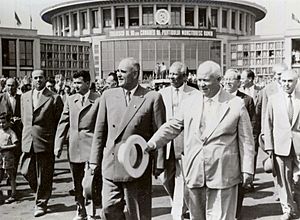
Gheorghiu-Dej started a new plan for Romania's economy and foreign policy. He decided to build a strong heavy industry. This went against the Soviet Union's plans for Romania to be mainly a farm country. For example, the Galați Steel Plant was built. Its production used iron ore imported from far away. In 1952, the Borzești Petrochemical Platform was started. The city of Onești was built nearby, mostly with the help of political prisoners.
Romania became a major steel producer. The machine-building and chemical industries also grew a lot. Romania started making civil and military aircraft, tanks, ships, and cars. However, these products were often expensive to make and not of the best quality.
Romania had to import many raw materials. The demand for steel and other industrial products later decreased worldwide. This made it hard for Romania to sell its goods. They often had to sell them at lower prices, mainly to developing countries.
Leading Romania
For the first five years, Romania was led by a group, with Groza as Prime Minister. But in 1952, Groza stepped down. Gheorghiu-Dej became Prime Minister, combining the two most powerful roles. He had the full support of the Soviet Union.
Gheorghiu-Dej briefly gave up the party leadership in 1954 to Gheorghe Apostol. But he remained the true leader of Romania. He regained the party leadership in 1955. In 1961, he became president of the new State Council. This made him the official head of state.
Gheorghiu-Dej was at first worried by Nikita Khrushchev's reforms in the Soviet Union. He then started to make Romania more independent. He ended the "Sov-Rom" companies. In 1958, the Red Army (Soviet troops) left Romania. This was a personal success for Gheorghiu-Dej. Romanian history books also started to mention Bessarabia as Romanian territory. This created tension with the Soviet Union.
However, the secret police, called the Securitate, was still used to control people. Romania joined other countries in cracking down on protests after the Hungarian Revolution of 1956.
In his later years, Gheorghiu-Dej started diplomatic relations with Western countries, including the United States. President Lyndon B. Johnson saw Romania as a somewhat friendly communist country. In 1964, many political prisoners were released.
Connecting with the West
In Gheorghiu-Dej's early years, Romania's relations with the West were difficult. There were accusations of spying and human rights issues. Trade between Romania and the West was low. In 1950, Romania's economic plan focused 89% of its trade only with the Soviet Bloc.
Later, Romania became more willing to trade with the West. In 1952, the journal Romanian Foreign Trade was published. It offered Western traders a chance to buy Romanian goods like petroleum and grain. Gheorghiu-Dej realized that trading with the West could improve living standards in Romania.
From 1953, Western countries slowly eased their trade limits. Gheorghiu-Dej wanted to connect Romania with the West. He made it easier for Western diplomats to travel in Bucharest. He also allowed Western journalists more access to Romania. In 1954, Romania asked Great Britain to discuss old claims, and Britain agreed.
Romania's foreign policy with the West was linked to its policy with the Soviet Union. Romania could only trade more with the West if it showed independence from the Soviet Union. Gheorghiu-Dej stressed Romania's right to be sovereign. In a 1955 speech, he talked about "national communism." He said Romania should follow its own interests, not be forced to follow others. He also discussed opening trade with the West.
In 1956, Gheorghiu-Dej told Romania's new ambassador to the U.S. to meet with the U.S. Secretary of State and President Dwight D. Eisenhower. As a result, the U.S. Department of State showed interest in increasing interaction.
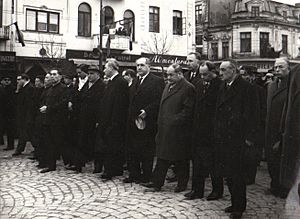
Interaction with the West briefly slowed after the 1956 Hungarian Revolution. Still, Gheorghiu-Dej continued to strengthen independence from the Soviet Union. For example, Romanian schools stopped requiring Russian language classes. Romania also supported the Moscow Declaration of 1957. This statement said that "Socialist countries base their relations on the principles of complete equality, respect for territorial integrity, state independence and sovereignty, and non-interference in one another's affairs." This matched Gheorghiu-Dej's goals.
By 1957, Romania had greatly increased its Western trade. Trade with the West made up 25% of Romania's total trade that year. By the early 1960s, Romania was more industrialized. After World War II, 80% of people worked in farming. By 1963, only 65% did, but farming was more productive. Gheorghiu-Dej also successfully shifted trade towards the West. Romania imported much of its industrial equipment from West Germany, Great Britain, and France.
By 1964, Gheorghiu-Dej made a trade agreement with the U.S. This allowed Romania to buy industrial products from them. This agreement happened because U.S. businesses complained they were losing money to Western Europe. President John F. Kennedy and later President Lyndon B. Johnson worked to increase trade with Eastern Europe.
Gheorghiu-Dej greatly increased trade with the West. This made Romania the first Soviet Bloc country to trade with the West independently. His policies made Romania more popular in the West. News reports in the U.S. changed from focusing on human rights abuses to Romania's growing independence. His efforts to expand foreign relations were clear at his funeral in March 1965. Thirty-three foreign groups attended, including a special envoy from General Charles de Gaulle of France. Gheorghiu-Dej's policies prepared the way for his successor, Nicolae Ceaușescu, to continue Romania's new direction.
Death and Legacy
Gheorghiu-Dej died of lung cancer in Bucharest on March 19, 1965. Some believed Gheorghe Apostol would become the next leader. However, Prime Minister Ion Gheorghe Maurer prevented this. Instead, he gathered support for Nicolae Ceaușescu, who had been a close associate of Gheorghiu-Dej. A former Romanian general, Ion Mihai Pacepa, later claimed that Ceaușescu said Gheorghiu-Dej was one of the leaders the Soviet Union tried to kill.
Gheorghiu-Dej was buried in a special tomb in Liberty Park (now Carol Park) in Bucharest. In 1991, after the Romanian Revolution, his body was moved. He was reburied at Bellu Cemetery. The Polytechnic Institute of Bucharest was once named after him. The city of Onești was also once called Gheorghe-Gheorghiu Dej. Even a Russian city, Liski, was named Georgiu-Dezh from 1965 to 1990.
Gheorghiu-Dej was married to Maria Alexe. They had two daughters, Vasilica (1928–1987) and Constantina (1931–2000).
Images for kids
See also
 In Spanish: Gheorghe Gheorghiu-Dej para niños
In Spanish: Gheorghe Gheorghiu-Dej para niños


